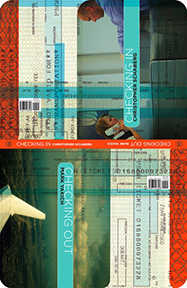After spending 25 days traveling with my son Blair, his girlfriend Helen, their friends Dave, Reena and Neil, I was flying home, leaving them to continue their exploration of the East Coast of Australia. Except for Dave, who had returned to his job in Queenstown on the South Island of New Zealand.
For the majority of the trip the five young ones, all in their mid-20s had me canyoning, kayaking, blo-karting, cave swimming and careening down mountains in a dry land luge while bumping along the North Island of New Zealand in a stick shift motor home. The motor home was designed for six—the prerequisite being that the six humans be comfortable climbing over and around one another’s sticky bodies. Still, we managed remarkably well. We went zorbing too. Imagine a giant hamster wheel with water to bathe and throw in several others buddies. Someone helps you jump inside, then pushes the hamster wheel, that is the zorb, off the top of a steep hill. Much screaming and excitement is involved. I wouldn’t have missed it for anything.
I was flying from Brisbane to Sydney, then to Auckland and home to Vancouver, Canada. We had explored the two Australian cities and the surfing mecca of Byron Bay. I had a blast.
Blair had given me strict instructions on how to navigate the Sydney airport. Mum, remember that you have to go from the domestic airport to the international one to catch your flight to Auckland. It began to dawn on me that role reversal was going on, son protecting mother as opposed to mother protecting son. I was also informed that I must text Blair once landing safely in Vancouver. I paid attention and promised to follow all the rules.
In-flight I was assigned a seat beside a Maori woman who wore the traditional moko—the tattoo designed for lips and chins of Maori women. This cultural identity is reserved for the indigenous people of New Zealand. I was in awe and, frankly, intimidated. The blue/black solidness of the tattoos made her fierce looking. I noticed that she had a young boy with her, a son, I assumed, about 10 years old.
On airplanes, passengers fall into threee categories: those who like to talk a lot; those who don’t talk at all; and, those who will engage in conversation if coaxed along. The first two categories can sometimes be rather painful for others. I am of the last category; I can be coaxed.
The usual airline lunch trays were being passed around by the stewards, but these looked and smelled better than your average airplane food fare. Flying Air New Zealand has been an excellent choice. The Maori woman and her son received their trays early on in the process while mine didn’t arrive.
Finally, she looked to me and asked in the sweetest voice and with that wonderful kiwi twang: “Why don’t we share this meal? Yours is a long time coming.”
How lovely. I thanked her and then miraculously my food tray appeared. “Ah, now we can all enjoy our food,” my seatmate said. She had actually waited quite some time before beginning her meal, I realized, in deference to me.
Then the chatting began. She was a social worker in her community assisting Maori people coping with addictions and mental illness. My work is similar and off we went, talking about cultural issues, the challenges of poverty and difficult family histories. The young boy was her foster son, a child born into a troubled life. The woman was a wisdom nugget and she explained that it was important that her son experience other cultures. This was the reason for visiting Sydney and now they were returning to their village north of Auckland. She wanted her son to leave his community so that he could return with an appreciation of his unique cultural identity of Maori life.
How lucky for me to have experienced the interlude. Arriving at the Vancouver International Airport about 16 hours later, I was immersed in -10 C temperatures. But the warmth of New Zealand and Australia, especially the Maori woman, has never left me.






